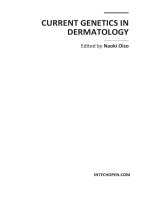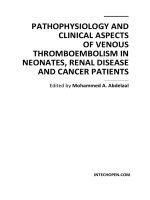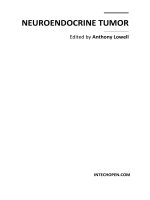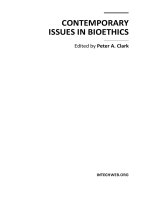Current Genetics in Dermatology Edited by Naoki Oiso docx
Bạn đang xem bản rút gọn của tài liệu. Xem và tải ngay bản đầy đủ của tài liệu tại đây (13.28 MB, 168 trang )
CURRENT GENETICS IN
DERMATOLOGY
Edited by Naoki Oiso
Current Genetics in Dermatology
Edited by Naoki Oiso
Contributors
Yutaka Shimomura, Ken Natsuga, Daisuke Tsuruta, Chiharu Tateishi, Masamitsu Ishii, Tamihiro
Kawakami, Naoki Oiso, Akira Kawada, Tomoki Kosho, Akira Kawada, Shigeru Kawara, Hajime
Nakano, Michihiro Kono, Masashi Akiyama, Masaaki Kawase, Miki Tanioka, Teruhiko Makino,
Takahiro Kurimoto, Muneharu Miyake, Akira Kawada
Published by InTech
Janeza Trdine 9, 51000 Rijeka, Croatia
Copyright © 2013 InTech
All chapters are Open Access distributed under the Creative Commons Attribution 3.0 license,
which allows users to download, copy and build upon published articles even for commercial
purposes, as long as the author and publisher are properly credited, which ensures maximum
dissemination and a wider impact of our publications. After this work has been published by
InTech, authors have the right to republish it, in whole or part, in any publication of which they
are the author, and to make other personal use of the work. Any republication, referencing or
personal use of the work must explicitly identify the original source.
Notice
Statements and opinions expressed in the chapters are these of the individual contributors and
not necessarily those of the editors or publisher. No responsibility is accepted for the accuracy
of information contained in the published chapters. The publisher assumes no responsibility for
any damage or injury to persons or property arising out of the use of any materials,
instructions, methods or ideas contained in the book.
Publishing Process Manager Iva Lipovic
Typesetting InTech Prepress, Novi Sad
Cover InTech Design Team
First published January, 2013
Printed in Croatia
A free online edition of this book is available at www.intechopen.com
Additional hard copies can be obtained from
Current Genetics in Dermatology, Edited by Naoki Oiso
p. cm.
ISBN 978-953-51-0971-6
Contents
Preface IX
Chapter 1 Current Genetics in Hair Diseases 1
Yutaka Shimomura
Chapter 2 Epidermolysis Bullosa Simplex 31
Ken Natsuga
Chapter 3 Junctional and Dystrophic Epidermolysis Bullosa 47
Daisuke Tsuruta, Chiharu Tateishi and Masamitsu Ishii
Chapter 4 Hereditary Palmoplantar Keratosis 55
Tamihiro Kawakami
Chapter 5 LEKTI: Netherton Syndrome and Atopic Dermatitis 67
Naoki Oiso and Akira Kawada
Chapter 6 Discovery and Delineation of Dermatan
4-O-Sulfotransferase-1 (D4ST1)-Deficient
Ehlers-Danlos Syndrome 73
Tomoki Kosho
Chapter 7 Eryhtropoietic Protoporphyria 87
Akira Kawada, Shigeru Kawara and Hajime Nakano
Chapter 8 Hermansky-Pudlak Syndrome 97
Naoki Oiso and Akira Kawada
Chapter 9 Dyschromatosis Symmetrica Hereditaria
and RNA Editing Enzyme 105
Michihiro Kono and Masashi Akiyama
Chapter 10 Genetics of Epidermodysplasia Verruciformis 121
Masaaki Kawase
VI Contents
Chapter 11 Maffucci Syndrome 133
Miki Tanioka
Chapter 12 Nevoid Basal Cell Carcinoma Syndrome (NBCCS) 137
Miki Tanioka
Chapter 13 Multiple Cutaneous and Uterine Leiomyomatosis 143
Teruhiko Makino
Chapter 14 CYLD Cutaneous Syndrome:
Familial Cylindromatosis, Brooke-Spiegler Syndrome
and Multiple Familial Trichoepitherioma 155
Takahiro Kurimoto, Naoki Oiso,
Muneharu Miyake and Akira Kawada
Preface
Recent genetic progress in the dermatologic field provides many novel findings.
“Current Genetics in Dermatology” is designed to summarize findings in each
genodermatosis. All of chapters are described by young and energetic dermatologists
who are specialists in each field.
We have to thank Ms. Iva Lipovic, Mr. Oliver Kurelic, Mrs. Ana Skalamera, and Ms.
Petra Nenadic for excellent help throughout the processes for publication. We also
appreciate all authors for sharing time for this book.
We hope you enjoy reading “Current Genetics in Dermatology”.
Naoki Oiso, M.D., Ph.D.
Associate Professor
Akira Kawada, M.D., Ph.D.
Chief Professor
Department of Dermatology
Kinki University Faculty of Medicine
Osaka-Sayama, Osaka,
Japan
Chapter 1
© 2013 Shimomura, licensee InTech. This is an open access chapter distributed under the terms of the
Creative Commons Attribution License ( which permits
unrestricted use, distribution, and reproduction in any medium, provided the original work is properly cited.
Current Genetics in Hair Diseases
Yutaka Shimomura
Additional information is available at the end of the chapter
1. Introduction
(HF) is a skin appendage which exists on the entire skin surface, except for palmoplantar
and mucosal regions. During embryogenesis, HF development is operated through
reciprocal interactions between skin epithelial cells and underlying dermal cells [1]. The first
signal to induce HF formation is considered to originate from the dermal cells. The epithelial
cells which receive the dermal signal lead to form a placode (Figure 1). Then a signal from
the placode results in forming a dermal condensate just beneath the placode (Figure 1).
Additional interaction between these structures induces the downgrowth of the placode and
forms a hair germ, which is the source of epithelial components of the HF (Figure 2). The
dermal condensate is gradually surrounded by the HF epithelium and becomes a dermal
papilla. It has been shown that many signaling molecules, such as Wnt, ectodysplasin (Eda),
Figure 1. Hair follicle placode (mouse embryo; E15.5)
Current Genetics in Dermatology
2
Figure 2. Hair germ (mouse embryo; E16.5)
bone morphogenic protein (Bmp), and sonic hedgehog (Shh), play crucial roles in the HF
development [1]. After the HF is generated, it undergoes dynamic cell kinetics, known as the
hair cycle, throughout postnatal life, which is composed of three phases: catagen
(regressing) phase, telogen (resting) phase and anagen (growing) phase [2]. In human scalp
HFs, duration of the catagen, telogen, and anagen phases are 1-2 weeks, 2-3 months, and 2-6
years, respectively. The hair cycle, which is an amazing ability of self-renewal, is maintained
by the stem cell niche in bulge portion of the HF, as well as the dermal papilla [3, 4].
Figure 3. Human anagen hair follicle.
Current Genetics in Hair Diseases
3
The anagen HF has a highly complex structure with several distinct cell layers (Figure 3).
During the anagen phase, cells from the bulge portion migrate downward to matrix region,
while making the outer root sheath (ORS). The matrix cells actively proliferate and
differentiate into the hair shaft, the inner root sheath (IRS), and the companion layer of the
HF (Figure 3) [4]. The hair shaft shares a common structural organization, in which a
multicellular cortex is surrounded by a cuticular layer, occasionally with a medulla layer
centrally located within the cortex. The hair shaft is strongly keratinized at the level of
keratinizing zone, and forms a rigid structure (Figure 3). Growth of the hair shaft is molded
and supported by the IRS, the companion layer, and the ORS. The IRS is composed of three
distinct layers: the IRS cuticle, Huxley’s layer, and Henle’s layer (Figure 3).
2. Hair follicle
Recent advances in molecular genetics have led to the identification of numerous genes that
are expressed in the HF. Furthermore, mutations in some of these genes have been shown to
underlie hereditary hair diseases in humans [2]. Causative genes for the diseases encode
various proteins with different functions, such as structural proteins, transcription factors,
and signaling molecules. This chapter aims to update recent findings regarding the
molecular basis of genetic hair diseases.
3. Keratin disorders
Keratins are one of the major structural components of the HF, and are largely divided into
type I (acidic) and type II (neutral to basic) keratins. The type I and type II keratins undergo
heterodimerization, which leads to form keratin intermediate filaments (KIFs) in the
cytoplasm [5]. Based on the amino acid composition, keratins are further classified into two
groups: epithelial (soft) keratins and hair (hard) keratins. As compared to the epithelial
keratins, the hair keratins show higher sulfur content in their N- and C-terminus, which
plays an important role in interacting with hair keratin-associated proteins via disulfide
bindings [6, 7]. All the keratin proteins are composed of an N-terminal rod domain, a central
rod domain, and a C-terminal tail domain. Importantly, the N-terminal and the C-terminal
regions of the rod domain are highly conserved in amino acid sequences, which are called
helix initiation motif (HIM) and helix termination motif (HTM), respectively (Figure 4). It is
believed that the HIM and the HTM play essential roles in heterodimerization between the
keratins. In humans, gene clusters for the type I and type II keratin genes are mapped on
chromosomes 17q21 [8] and 12q13 [9], respectively. To date, a total of 54 functional keratin
genes (28 type I and 26 type II) have been identified and characterized in humans. It has
been shown that during differentiation of the HF, various keratin genes are abundantly and
differentially expressed, and contribute to HF keratinization, leading to the formation of a
rigid structure [10]. In general, epithelial keratins are mainly expressed in the ORS, the
companion layer, the IRS, while hair keratins are predominantly expressed in the hair shaft.
In addition, it has recently been reported that some epithelial keratins are expressed in the
hair shaft medulla as well [11]. It is noteworthy that mutations in several keratin genes have
been reported to underlie hereditary hair disorders in humans (Table 1).
Current Genetics in Dermatology
4
Figure 4. Structure of keratin proteins.
disease inheritance
pattern
OMIM# main symptoms gene protein, function
Monilethrix AD 158000 moniliform hair,
perifollicular
papules
KRT81
KRT83
KRT86
K81 (basic hair
keratin)
K83 (basic hair
keratin)
K86 (basic hair
keratin)
Pure hair and nail
ectodermal
dysplasia
AR 602032 hypotrichosis,
spoon nails
KRT85 K85 (basic hair
keratin)
Autosomal
dominant woolly
hair (ADWH)/
hypotrichosis
AD 194300/613981 WH/
hypotrichosis
KRT74
KRT71
K74 (basic epithelial
keratin)
K71 (basic epithelial
keratin)
Table 1. Hereditary hair disorders caused by mutations in keratin genes. AD, autosomal dominant;
AR, autosomal recessive.
Monilethrix is characterized clinically by fragile scalp hair shafts and diffuse perifollicular
papules with erythema. As the hair of affected individuals with monilethrix is easily broken,
they frequently show sparse hair (hypotrichosis). In most cases, monilethrix shows an
autosomal dominant inheritance pattern (MIM 158000), while autosomal recessive forms
(MIM 252200) also exist. Under microscopy, the hair shaft of affected individuals with
monilethrix dysplays a characteristic anomaly, known as beaded or moniliform hair, which
shows periodic changes in hair diameter. As a result, the hair leads to the formation of
nodes and internodes (Figure 5) [12]. Autosomal dominant form of the disease is caused by
heterozygous mutations in KRT81, KRT83, and KRT86 genes, which encode type II hair
keratins K81, K83, and K86, respectively [13, 14]. All the mutations identified to date result
in a deleterious amino acid substitution within either the HIM or the HTM of the rod
domain. These hair keratins are predominantly expressed in the keratinizing zone of the
hair shaft cortex (Figure 6) [15]. Although precise mechanisms to cause moniliform hair
remain elusive, mutations in these hair keratin genes are predicted to result in disruption of
the KIF formation, leading to an abnormal hair shaft keratinization.
Current Genetics in Hair Diseases
5
Figure 5. Moniliform hair. N, node; in, internode.
Figure 6. Expression of hair keratin K86 in the human hair shaft cortex.
Pure hair and nail ectodermal dysplasia (PHNED; MIM 602032) is characterized by absent or
sparse hair, as well as nail dystrophy [16]. Hairs of affected individuals with PHNED are short
Current Genetics in Dermatology
6
and thin, and perifollicular papules can also be observed. In addition, their nails typically
show koilonychia (spoon nails). The disease can show either an autosomal dominant or
recessive inheritance trait. The autosomal recessive form has been mapped to chromosome
17p12-q21.2 [17] and 12p11.1-q21.1 [18] which contain the type I and type II keratin gene
clusters, respectively. Subsequently, homozygous mutations in KRT85 gene have been
identified in families with autosomal recessive PHNED [18, 19]. The KRT85 gene encodes the
type II hair keratin K85, which is abundantly expressed in the matrix region of both the HF
and the nail units [15, 20]. Molecular basis for autosomal dominant PHNED is yet unknown.
In addition to hair keratins, it has recently been reported that mutations in HF-specific
epithelial keratin genes are associated with hereditary woolly hair (WH)/hypotrichosis. WH is
defined as an abnormal variant of tightly curled hair and is considered to be a kind of hair
growth deficiency [21]. There are both syndromic and non-syndromic forms of WH. The non-
syndromic forms of WH can show either an autosomal-dominant (ADWH; MIM 194300) or -
recessive (ARWH; MIM 278150) inheritance pattern. It is well-known that WH is frequently
associated with hypotrichosis. Recently, heterozygous mutations in KRT74 and KRT71 genes
have been identified in families with ADWH/hypotrichosis (Figure 7) [22-24]. Importantly, the
KRT74 and the KRT71 genes encode the IRS-specific type II epithelial keratins K74 and K71,
respectively (Figure 8) [25]. It can be postulated that disruption of the KIF formation in the IRS
results in a failure to guide the hair growth, and leads to WH phenotype. Interestingly, KRT71
mutations have also been identified in mice, rats, cats, and dogs, all of which show wavy coat
phenotypes [26-30]. These data strongly suggest crucial roles of the IRS-specific epithelial
keratins in the HF development and hair growth across mammalian species.
Figure 7. Clinical features of autosomal dominant woolly hair/hypotrichosis caused by a mutation in
the KRT71 gene.
Current Genetics in Hair Diseases
7
Figure 8. Expression of the IRS-specific karatin K71 in the human hair follicle.
4. Hereditary hair disorders resulting from disruption of cell-cell
adhesion molecules
Similar to epidermis, the HF epithelium possess a number of cell-cell adhesion structures,
such as desmosomes, corneodesmosomes, adherens junctions, gap junctions, and tight
junctions, which play important roles in maintaining the structure and the function of the
HF. It has been shown that disruption of any of these structures can result in hereditary hair
disorders in humans (Table 2).
Desmosome is a critical structure for cell-cell adhesion in most epithelial tissues, including
the HF. The major structural component of the desmosome is the desmosomal cadherin
family, which is comprised of the desmogleins (DSGs) and desmocollins (DSCs). In humans,
4 DSG genes (DSG1-DSG4) and 3 DSC genes (DSC1-DSC3) are located on chromosome
18q12. These desmosomal cadherin family members are glycoproteins with single-pass
transmembrane domain, and are involved in Ca
2+
-dependent cell-cell adhesion, connecting
with each other using their extracellular domains [31]. Within the cytoplasm, they interact
with several other proteins, known as desmosomal plaque proteins, which include
plakoglobin, plakophilin, and desmoplakin. The desmosomal plaque proteins contribute to
anchor the KIF near the cell membrane. As such, the cell integrity and the cell-cell adhesion
are maintained [31]. Recessively-inherited mutations in the DSG4 gene have been shown to
cause a non-syndromic form of hereditary hair disorder known as localized autosomal
recessive hypotrichosis 1 (LAH1; MIM 607903) [32]. Affected individuals with LAH1 show
sparse hairs on the scalp, chest, arms, and legs. The eyebrows and beard are less dense than
normal, and the axillary hair, pubic hair, and eyelashes look normal in most cases. It is
noteworthy that hair shafts of affected individuals with DSG4 mutations are fragile and
often show moniliform hair [33-35]. Therefore, the DSG4 can also be regarded as a causative
Current Genetics in Dermatology
8
disease inheritance
pattern
OMIM# main symptoms gene protein, function
Localized autosomal recessive
hypotrichosis 1
(LAH1)/monilethrix
AR 607903/
252200
hypotrichosis,
moniliform hair,
perifollicular papules
DSG4 desmoglein 4
Hypotrichosis and recurrent skin
vesicles
AR 613102 Hypotrichosis, skin
vesicles or keratosis
pilaris
DSC3 desmocollin 3
Naxos disease AR 601214 WH, PPK, right
ventricular
cardiomyopathy
JUP junctional
plakoglobin
Carvajal syndrome AR 605676 WH, PPK, left
ventricular
cardiomyopathy
DSP desmoplakin
Ectodermal dysplasia/skin
fragility syndrome
AR 604536 Hypotrichosis, fragile
skin, nail dystrophy
PKP1 plakophilin 1
Hypotrichosis simplex of the
scalp
AD 146520 Scalp-limited
hypotrichosis
CDSN corneodesmosin
Netherton syndrome AR 256500 ichthyosiform
erythroderma, atopic
manifestation,
bamboo hair
SPINK5 LEKTI (serine
protease
inhibitor)
Ichthyosis with hypotrichosis AR 610765 ichthyosis,
hypotrichosis
ST14 matriptase (serine
protease)
Hypotrichosis with juvenile
macular dystrophy
AR 601553 Hypotrichosis, weak
eyesight
CDH3 P-cadherin
Ectodermal dysplasia,
ectrodactyly, macular dystrophy
(EEM) syndrome
AR 225280 Hypotrichosis, weak
eyesight, ectrodactyly
CDH3 P-cadherin
Hidrotic ectodermal dysplasia
(Clouston syndrome)
AD 129500 hypotrichosis, PPK,
nail dystrophy
GJB6 connexin 30
Keratitis ichthyosis deafness
(KID) syndrome
AD 148210 vascularizing
keratitis, sensorial
deafness,
erythrokeratoderma,
hypotrichosis
GJB2
GJB6
connexin 26
connexin 30
Ichthyosis, leukocyte vacuoles,
alopecia, and sclerosing
cholangitis
AR 607626 Hypotrichosis,
ichthyosis, jaundice,
hapatomegaly,
CLDN1 claudin 1
AD, autosomal dominant; AR, autosomal recessive; WH, woolly hair; PPK, palmoplantar keratoderma.
Table 2. Hereditary hair disorders caused by disruption of cell-cell adhesion structures and the related
molecules.
Current Genetics in Hair Diseases
9
gene for autosomal recessive monilethrix. DSG4 is the only desmoglein member that is
expressed in the hair shaft (Figure 9) [36], and its expression in the hair shaft cortex finely
overlaps with K81, K83, and K86, of which mutations cause autosomal dominant
monilethrix. More recently, a homozygous nonsense mutation in the DSC3 gene has been
identified in a family with an autosomal recessive form of hypotrichosis [37]. The disease is
characterized by sparse scalp hairs and small vesicle formation on the scalp and extremities
(hypotrichosis and recurrent skin vesicles; MIM 613102) [37], while there is an argument
that the vesicles may be keratosis pilaris [38]. In addition, mutations in genes encoding
desmosomal plaque proteins can also show hair phenotypes (Table 2). For example,
mutations in junctional plakoglobin (JUP) and desmoplakin (DSP) genes are known to
underlie Naxos disease (MIM 601214) and Carvajal syndrome (MIM 605676), respectively
[39, 40]. Both diseases show an autosomal recessive inheritance pattern and are
characterized by woolly hair, palmoplantar keratoderma, and severe cardiomyopathy.
Furthermore, loss of function mutations in plakophilin 1 (PKP1) gene cause a rare autosomal
recessive disease named ectodermal dysplasia/skin fragility syndrome (MIM 604536) [41].
Corneodesmosome is a modified desmosome in the stratum corneum (SC) of the epidermis,
and plays a crucial in the desquamation process. One of the major components of the
corneodesmosome is corneodesmosin (CDSN). CDSN is secreted by cytoplasmic vesicles
into the extracellular core of desmosomes, and is progressively proteolysed by several serine
Figure 9. Expression of desmoglein 4 (DSG4) in the human hair shaft.
Current Genetics in Dermatology
10
proteases, such as kallikrein-related peptidases, which leads to the loss of cell-cell adhesivity in
the SC and causes desquamation [42]. CDSN is also expressed predominantly in the IRS of the
HF, and thus is considered to be important for terminal differentiation, as well as subsequent
degradation of the IRS [43]. In 2003, heterozygous nonsense mutations in the CDSN gene have
been identified in patients with hereditary hypotrichosis simplex of the scalp (HHSS; MIM
146520), which is an autosomal dominant disorder characterized by sparse hairs limited to the
scalp region without any obvious hair shaft anomalies (Figure 10) [44]. Histologically, the IRS
of the patients’ HF was disturbed, which was consistent with the expression of CDSN in the
IRS. Furthermore, aggregates of abnormal CDSN were detected around the HF, as well as in
the papillary dermis in patients’ skin [44]. These aggregates have recently been shown to be an
amyloid protein derived from the mutant CDSN, which is likely to be toxic to the HF cells [45].
Therefore, the mutant CDSN protein appears to function in a dominant negative manner,
affect growth of the HF, and lead to HHSS. In addition to HHSS, it has been reported that
mutations in other genes functionally related with CDSN can show some hair phenotypes
associated with congenital ichthyosis. Of these, Netherton syndrome (NS; MIM 256500) is a
rare autosomal recessive condition characterized by ichthyosiform erythroderma, atopic
manifestation, and the hair shaft anomaly, known as bamboo hair (trichorrhexis invaginata)
(Figure 11). The NS is caused by loss of function mutations in SPINK5 gene which encodes a
serine protease inhibitor named LEKTI (lymphoepithelial Kazal-type-related inhibitor) [46].
Disruption of LEKTI has been shown to result in upregulation of serine proteases and excess
desquamation due to premature proteolysis of CDSN [47, 48]. Furthermore, it has been
reported that recessively-inherited mutations in ST14 gene, which encodes a member of serine
proteases (matriptase), underlie ichthyosis with hypotrichosis syndrome (MIM 610765) [49].
Sum of these genetic data suggest that balanced expression of CDSN, serine proteases, and
their inhibitors is critical for the HF differentiation.
Figure 10. Clinical features of hypotrichosis simplex of the scalp.
Current Genetics in Hair Diseases
11
Figure 11. Bamboo hair (trichorrhexis invaginata).
E- and P-cadherins are classical cadherins which are a major component of adherens
junctions in the HF. When the HF placode is formed during embryogenesis, the expression
of E-cadherin is markedly downregulated, while P-cadherin is simultaneously upregulated,
and prominant expression of P-cadherin persists in the proximal portion of the HF. This
phenomenon, known as cadherin switching, is believed to be essential for the HF
morphogenesis [50]. In addition, P-cadherin has recently been shown to be important for
postnatal hair growth and cycling as well [51]. The critical role of these classical cadherins in
the HF has been further supported by two hereditary diseases resulting from mutations in
the P-cadherin gene (CDH3). First, mutations in the CDH3 gene are known to underlie
hypotrichosis with juvenile macular dystrophy (HJMD; MIM 601553), which is an
autosomal recessive disease characterized by sparse hair and weak eyesight due to macular
dystrophy of the retina [52]. In addition, it has been reported that another disease,
ectodermal dysplasia, ectrodactyly and macular dystrophy (EEM syndrome; MIM 225280),
is also caused by recessively-inherited mutations in the CDH3 gene [53]. Affected
individuals with EEM syndrome show common hair and eye phenotype with HJMD.
However, EEM patients also shows split hand/foot malformation (ectrodactyly), suggesting
crucial roles of P-cadherin in the development of not only hair and retina, but also the limbs
in humans. There are no clear genotype-phenotype correlations in CDH3 mutations, as it has
been reported that a same mutation in the CDH3 gene caused HJMD in one family [54],
while EEM syndrome in another family [53]. Identification of modifier gene(s) may reveal
this paradox in the future.
Gap junction (GJ) is a specialized intercellular structure that provides a pathway for both
metabolic and ionic coupling between adjacent cells and maintains tissue homeostasis [55].
Connexins (Cxs) are 4-pass transmembrane proteins and the major component of the GJs.
Clouston syndrome (MIM 129500), also known as hidrotic ectodermal dysplasia, is an
autosomal dominant condition characterized by hypotrichosis, nail dystrophy, and
Current Genetics in Dermatology
12
palmoplantar keratoderma. The disease is caused by mutations in GJB6 gene which encodes
Cx30 [56]. In addition, mutations in GJB2 gene encoding Cx26 are known to underlie
keratitis-ichthyosis-deafness syndrome (KID; MIM 148210) [57]. The triad of KID is
vascularizing keratitis, profound sensorial hearing loss, and erythrokeratoderma.
Additionally, patients with KID show severe hypotrichosis in high frequency. Interestingly,
it has been reported that a mutation in the GJB6 gene (V37E) can show phenotypes
resembling KID [58]. These Cx proteins are mainly expressed in the ORS of the HF (Figure
12) [59, 60], and thus they may play some roles in maintaining the function of the HF stem
cells.
Figure 12. Cx30 expression in the human hair follicle.
In addition to the cell-cell adhesion structures described above, tight junction (TJ) also exists
in the HF epithelium and expression patterns of TJ-associated proteins in the HF have
previously been characterized [61]. Disruption of CLDN1 gene encoding claudin 1, a major
structural component of TJ, has recently been shown to cause a severe autosomal recessive
syndrome, known as ichthyosis, leukocyte vacuoles, alopecia, and sclerosing cholangitis
(MIM 607626) [62].
5. Hereditary hair disorders associated with transcription factors
During the past 20 years, numerous genes that are expressed in the HF have been identified,
and various transcription factors have been shown to be involved in transcriptional
Current Genetics in Hair Diseases
13
regulation of these genes. Of these, p63 is one of the main transcription factors expressed in
the HF. During the HF morphogenesis, p63 is abundantly expressed in the HF placode
(Figure 13). In the postnatal stage, it is strongly expressed in the ORS and the matrix region
of the HF (Figure 14). It has previously been reported that mutations in TP63 gene encoding
p63 cause several autosomal dominant diseases including ectodermal dysplasia,
ectrodactyly, cleft lip/palate (EEC) syndrome (MIM 604292), ankyloblepharon, ectodermal
defects, and cleft lip/palate (AEC) syndrome (MIM 106260) and Rapp-Hodgkin syndrome
(MIM 129400) (Table 3) [63-65]. In most cases, patients with these syndromes result in
scarring alopecia, and their hair shafts are coarse and twisted (Figure 15). It is noteworthy
that affected individuals with TP63 mutations show large phenotypic overlaps in hair and
limbs with P-cadherin (CDH3) mutations. p63 colocalizes with P-cadherin in developing HF
placode and limb buds during mouse embryogenesis. Importantly, it has been
demonstrated that the CDH3 is a direct target gene of p63 [66].
Figure 13. P63 expression in the developing mouse hair follicle placode.
Figure 14. p63 expression in the human hair follicle.
Current Genetics in Dermatology
14
disease inheritance
pattern
OMIM# main symptoms gene Protein,
function
Ectrodactyly,
ectodermal dysplasia,
and cleft lip/palate
(EEC ) syndrome
AD 604292 hypotrichosis,
ectrodactyly, cleft
lip/palate,
hypodontia
TP63 tumor protein
p63
Ankyloblepharon,
ectodermal defects,
and cleft lip/palate
(AEC) syndrome
AD 106260 hypotrichosis,
ankyloblepharon,
skin erosion, cleft
lip/palate,
hypodontia
TP63 tumor protein
p63
Rapp-Hodgkin
syndrome
AD 129400 hypotrichosis, cleft
lip/palate,
hypodontia
TP63 tumor protein
p63
T cell
immunodeficiency,
congenital alopecia,
and nail dystrophy
(human nude
phenotype)
AR 601705 atrichia, nail
dystrophy, T-cell
immuodeficiency
FOXN1 Forkhead box
N1
Atrichia with papular
lesions
AR 209500 atrichia, papules HR Hair less
(transcriptional
corepressor)
Marie-Unna hereditary
hypotrichosis
AD 146550 Hypotrichosis,
wiry hair
U2HR Small peptide
that regulates
translation of
the HR protein
Trichorhinophalangeal
syndrome type I/type
III
AD 190350/190351 Hypotrichosis,
peer-shaped nose,
brachydactyly,
clinodactyly
TRPS1 Zing finger
transcription
factor
Hypotrichosis-
lymphedema-
telangiectasia
syndrome
AD/AR 607823 Hypotrichosis,
lymphedema,
telangiectasia
(easily visible
blood vessels)
SOX18 SRY-BOX 18
Trichodontoosseous
syndrome
AD 190320 WH, hypodontia,
bone anomalies
DLX3 Distal-less
homeobox 3
AD, autosomal dominant; AR, autosomal recessive; WH, woolly hair.
Table 3. Hereditary hair disorders resulting from mutations in transcription factors.
FOXN1, also known as WHN, is a transcription factor expressed in the matrix and the hair
shaft of the HF, and has been shown to regulate the expression of several hair keratin genes
[67]. FOXN1 is expressed in not only the HF, but also in the nail units and thymus.
Mutations in the FOXN1 gene have been reported to underlie T-cell immunodeficiency,
congenital alopecia, and nail dystrophy (MIM 601705), which is an autosomal recessive
disease and represents the human counterpart of the nude mouse phenotype, suggesting the
crucial roles of FOXN1 in development of skin appendages, as well as thymus in both
humans and mice [68].
Current Genetics in Hair Diseases
15
Figure 15. Clinical features of Rapp-Hodgkin syndrome.
Hairless (HR) is a putative single zinc-finger transcription factor which is known to regulate
the catagen phase of the hair cycle [69]. Recessively-inherited mutations in the HR gene have
been shown to underlie atrichia with popular lesions (APL; MIM 209500) [70]. APL is
characterized by early onset of generalized complete hair loss (atrichia), which is followed
by papular eruptions due to formation of dermal cyst after an abnormal first catagen phase
[71]. Mutations responsible for APL have been found in coding exons or exon-intron
boundary sequences of the HR gene, all of which were predicted to result in loss of
expression and/or function of the HR protein. Recently, another disease, known as Marie-
Unna hypotrichosis (MUH; MIM 146550), has been shown to be associated with the HR
gene. MUH is a non-syndromic hereditary hair disorder showing an autosomal dominant
inheritance pattern. Affected individuals with MUH typically exhibit sparse scalp and facial
hair at birth. Subsequently, coarse, wiry, and twisted hairs develop in early childhood. Hair
loss progresses with aging, which leads to a complete alopecia or a phenotype just like
androgenetic alopecia. MUH was previously mapped to the HR locus on chromosome
8p21.3 [72]. However, direct sequencing analysis of coding sequences of the HR gene failed
to detect mutations. Later on, Wen et al. found that the promoter region of the HR gene has
four potential upstream open reading frames (uORFs), which were designated U1HR-U4HR.
Strikingly, direct sequencing analysis of the U1HR-U4HR in patients with MUH has led to
the identification of mutations within the U2HR sequences, which encode a small peptide of
34 amino acid residues [73]. In vitro studies have suggested that this small peptide encoded
by the U2HR downregulates the HR expression at the translational level, and loss-of-
function mutations in the U2HR results in overexpression of the HR protein [73]. Besides
these findings, actual consequences resulting from U2HR mutations in vivo remain elusive.
TRPS1 is a transcription factor with GATA-type and Ikaros-type zinc finger domains, which
has been shown to be abundantly expressed in both epithelial and mesenchymal
components in the developing mouse HFs [74]. Furthermore, it has recently been reported
that Trps1 plays crucial roles in regulating the expression of several Wnt inhibitors and
various transcription factors during vibrissa follicle morphogenesis in mice [75]. In humans,









